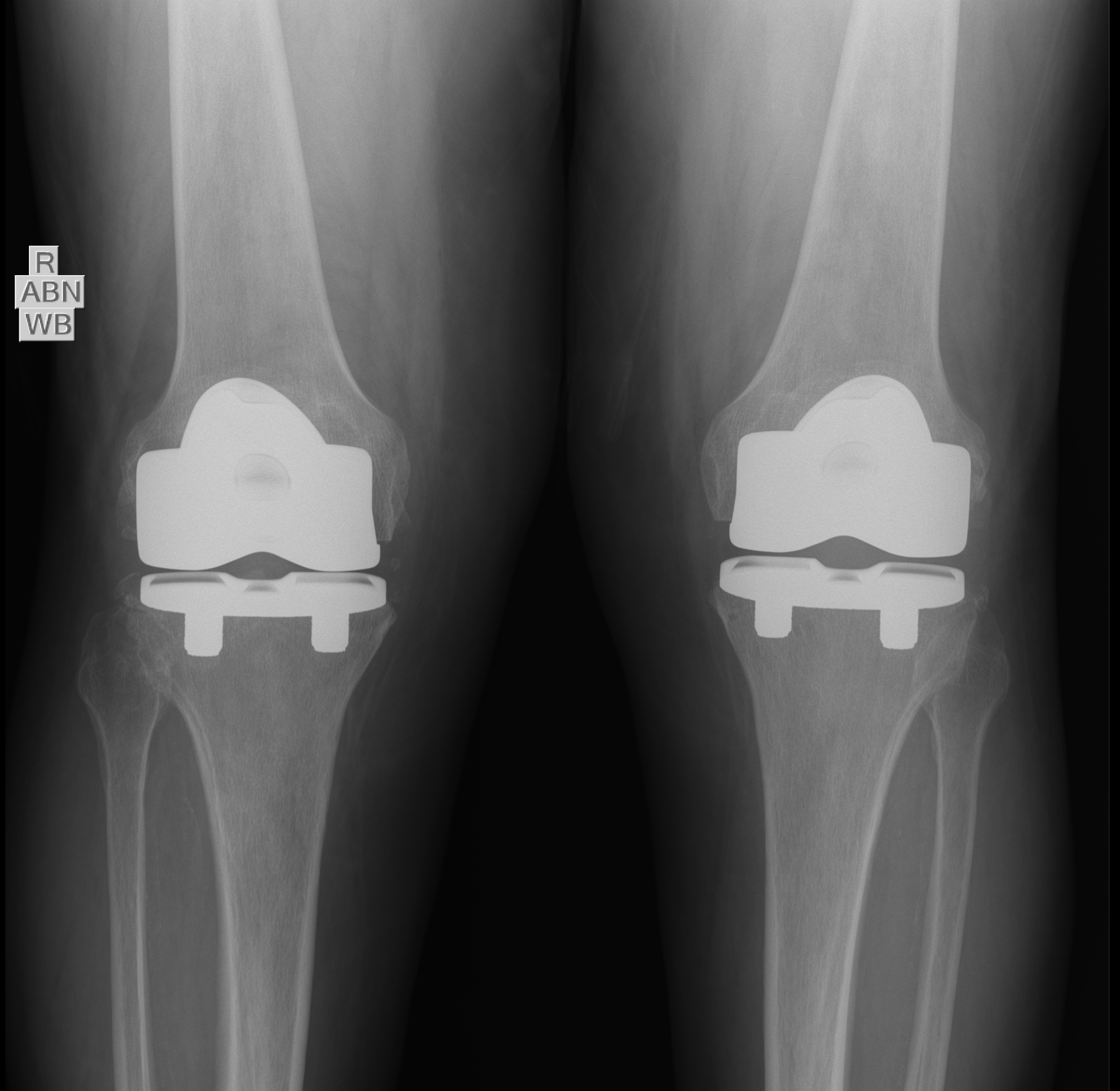Joint Replacement Surgery
Total Hip Replacement:
What is a Hip Replacement?
A hip replacement or “total hip arthroplasty” is a surgical procedure designed to replace a worn out hip joint. Most hip replacements are made up of 4 main parts.
Stem: a metal (usually titanium) stem is inserted in the hollow part of the femur.
Socket: a metal (usually titanium) socket is impacted into the acetabulum which is your natural socket.
Liner: a liner made of a special plastic (ultra high molecular weight polyethylene) snaps into the metal socket to replace your cartilage.
Head Ball: a ball made of metal (cobalt chrome) or ceramic (biolux delta) is fitted to the stem to replace your femoral head.
Why are Hip Replacements Performed?
A person’s hip can wear out for a variety of reasons including osteoarthritis, post-traumatic arthritis, inflammatory diseases and avascular necrosis among other causes. As a joint wears out, it can become stiff and painful.
Before proceeding with surgery, Dr. Horberg and his team will discuss non-surgical, “conservative” options to treat your pain. This can include simple things like rest, ice, elevation, weight loss or activity modification. Physical therapy, anti-inflammatory medications and injections can also provide relief. For patients who do not get relief from conservative options, hip replacement surgery is an option. The goal of surgery is to provide pain relief, improved motion and help patient return to their favorite activities.
How is Hip Replacement Performed?
A hip replacement can be preformed through a variety of surgical “approaches” which each have their own benefits. Dr. Horberg performs all of his primary and revision hip replacements through a minimally invasive direct anterior approach. Numerous studies have shown that patients recover faster with less pain after hip replacement through this approach. The direct anterior approach has also been shown to have a lower rate of complications such as dislocation after surgery. In fact, patients undergoing hip replacement via a direct anterior approach require no post-operative bracing or restrictions, unlike other approaches such as the posterior approach.
The Importance of Experience and Specialization
Like much of medicine, Orthopaedic Surgery has become a highly specialized field. Joint replacement surgery is no exception. While many Orthopaedic surgeons perform joint replacement as a part of their practice, multiple studies clearly show that patients who have their joint replacement surgery performed by a fellowship trained joint replacement specialist have faster recovery with better outcomes and fewer complications.
Dr. Horberg is a fellowship trained joint replacement specialist who performs hundreds of hip, knee and shoulder replacements every year. In fact, Dr. Horberg is a nationally recognized expert in primary, complex and revision hip replacement. He travels around the country to teach other surgeons to perform these procedures via a minimally invasive direct anterior approach. He has also published clinical research and book chapters on the topic.
Total Knee Replacement:
What is a Knee Replacement?
A knee replacement or “total knee arthroplasty” is a surgical procedure designed to replace a worn out knee joint. Most knee replacements are made up of 3 or 4 main parts.
Femur: a curved metal cap is fit to the bottom part of the femur.
Tibia: a flat metal baseplate is fit to the the top part of the tibia.
Liner: a liner made of a special plastic (ultra high molecular weight polyethylene) snaps onto the to replace your cartilage.
Patella: a button made of a special plastic (ultra high molecular weight polyethylene) is sometimes used to resurface the kneecap (patella).
Why are Knee Replacements Performed?
A person’s knee can wear out for a variety of reasons including osteoarthritis, post-traumatic arthritis, inflammatory diseases and avascular necrosis among other causes. As a joint wears out, it can become stiff and painful.
Before proceeding with surgery, Dr. Horberg and his team will discuss non-surgical, “conservative” options to treat your pain. This can include simple things like rest, ice, elevation, weight loss or activity modification. Physical therapy, anti-inflammatory medications and injections can also provide relief. For patients who do not get relief from conservative options, knee replacement surgery is an option. The goal of surgery is to provide pain relief, improved motion and help patient return to their favorite activities.
How is Knee Replacement Performed?
A knee replacement is typically performed using an incision over the midline of the knee. Different measuring devices, jigs and even robotic instruments are used to precisely align the components to ensure an appropriate fit and alignment of the components. These components are then either cemented or press fit in place depending on each patients bone quality and deformity.
The Importance of Experience and Specialization
Like much of medicine, Orthopaedic Surgery has become a highly specialized field. Joint replacement surgery is no exception. While many Orthopaedic surgeons perform joint replacement as a part of their practice, multiple studies clearly show that patients who have their joint replacement surgery performed by a fellowship trained joint replacement specialist have faster recovery with better outcomes and fewer complications.
Dr. Horberg is a fellowship trained joint replacement specialist who performs hundreds of hip, knee and shoulder replacements every year. In fact, Dr. Horberg is a nationally recognized expert in primary, complex and revision knee replacement. He travels around the country to teach other surgeons to perform these procedures using both conventional and robotic means. He has also published clinical research on knee replacement.
Total Shoulder Replacement:
What is a Shoulder Replacement?
A knee replacement or “total shoulder arthroplasty” is a surgical procedure designed to replace a worn out shoulder joint. There are two principle types of shoulder replacement that are selected based what kind of wear the shoulder has.
Anatomic Shoulder Replacement: The shoulder is replaced with a “ball and socket” that closely match the patient’s anatomy. This requires a healthy, intact rotator cuff to perform.
Reverse Shoulder Replacement: The “ball and socket” are reversed in patients with damaged rotator cuffs to allow other muscles to help move the shoulder.
Most shoulder replacements are made up of 3 or 4 main parts.
Stem: A stem is fit into the hollow part of the humerus (upper arm bone).
Glenoid: the glenoid (shoulder socket) is either fitted with a metal baseplate to attach a metal “glenosphere” in a reverse shoulder replacement or a socket made out of a special plastic (ultra high molecular weight polyethylene).
Glenosphere: in reverse shoulder replacement, the glenosphere is used to convert your normal socket to a ball shape.
Humeral Surface: in reverse shoulder replacement, a socket shaped liner is attached to the humeral stem. In anatomic shoulder replacement, rounded metal surface is used to replace the arthritic bone that is removed.
Why are Shoulder Replacements Performed?
A person’s shoulder can wear out for a variety of reasons including osteoarthritis, rotator cuff damage, post-traumatic arthritis, inflammatory diseases and avascular necrosis among other causes. As a joint wears out, it can become weak, stiff and painful.
Before proceeding with surgery, Dr. Horberg and his team will discuss non-surgical, “conservative” options to treat your pain. This can include simple things like rest, ice, elevation, weight loss or activity modification. Physical therapy, anti-inflammatory medications and injections can also provide relief. For patients who do not get relief from conservative options, shoulder replacement surgery is an option. The goal of surgery is to provide pain relief, improved motion and help patient return to their favorite activities.
How is Shoulder Replacement Performed?
A shoulder replacement is typically performed using an incision over the front of the shoulder between the deltoid and pectoralis major muscles. Different measuring devices, jigs and even robotic instruments are used to precisely align the components to ensure an appropriate fit and alignment of the components. These components are then either cemented or press fit in place depending on each patients bone quality and deformity.
The Importance of Experience and Specialization
Like much of medicine, Orthopaedic Surgery has become a highly specialized field. Joint replacement surgery is no exception. While many Orthopaedic surgeons perform joint replacement as a part of their practice, multiple studies clearly show that patients who have their joint replacement surgery performed by a fellowship trained joint replacement specialist have faster recovery with better outcomes and fewer complications.
Dr. Horberg is a fellowship trained joint replacement specialist who performs hundreds of hip, knee and shoulder replacements every year.






